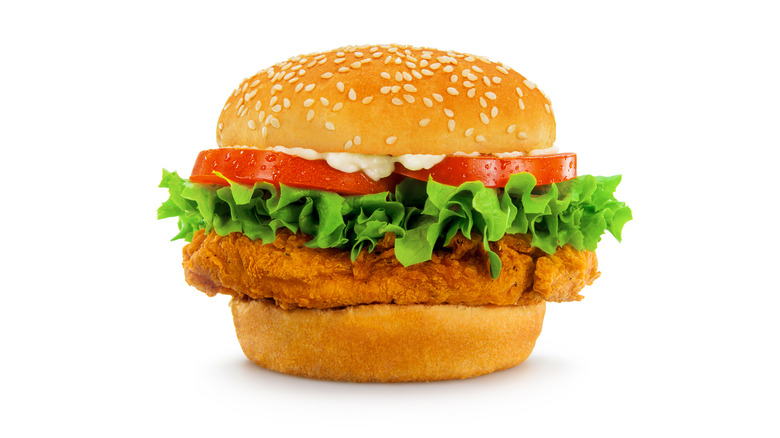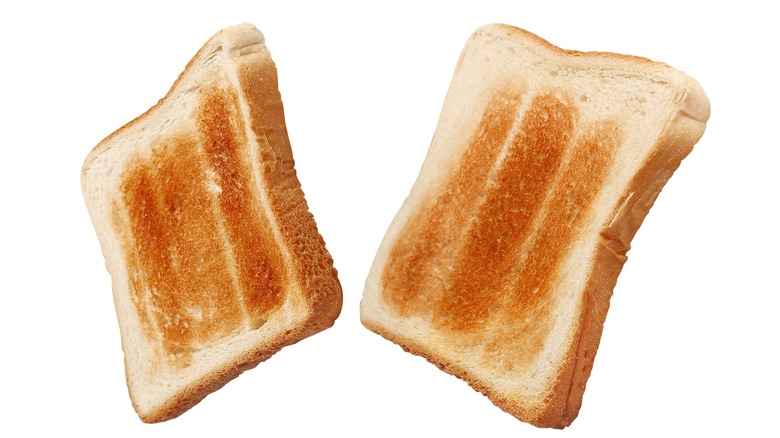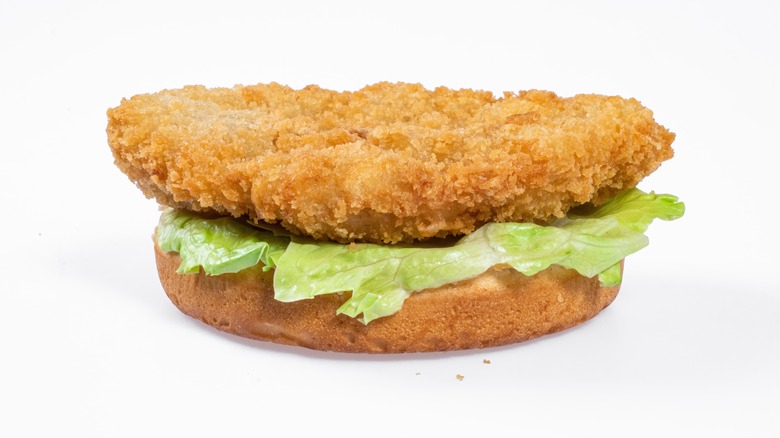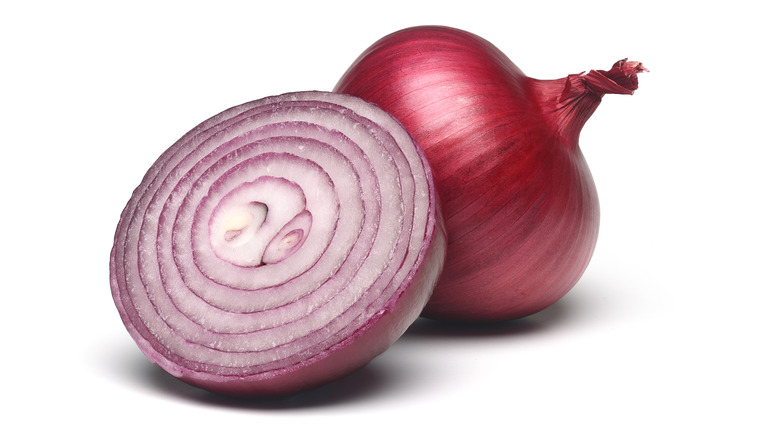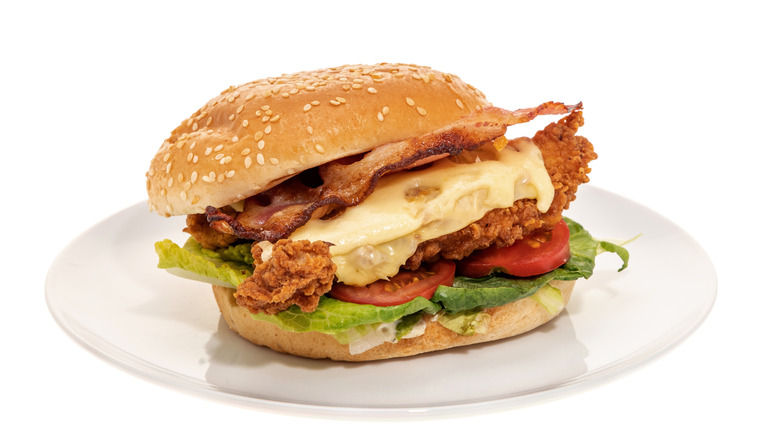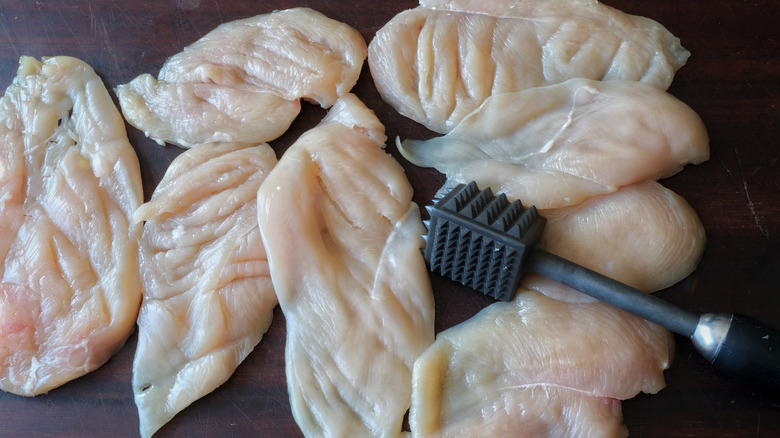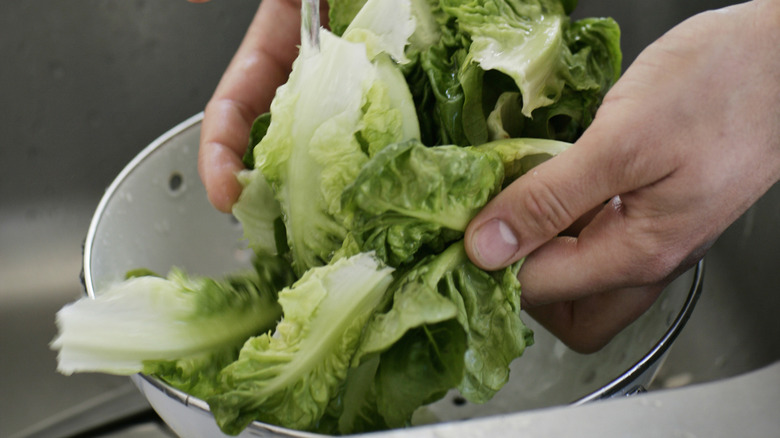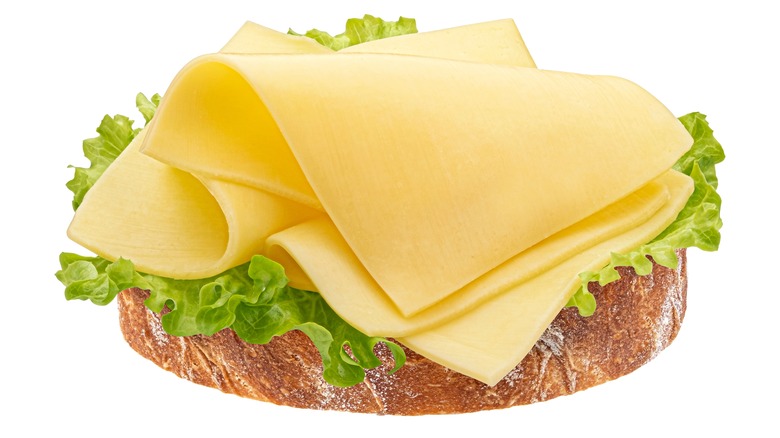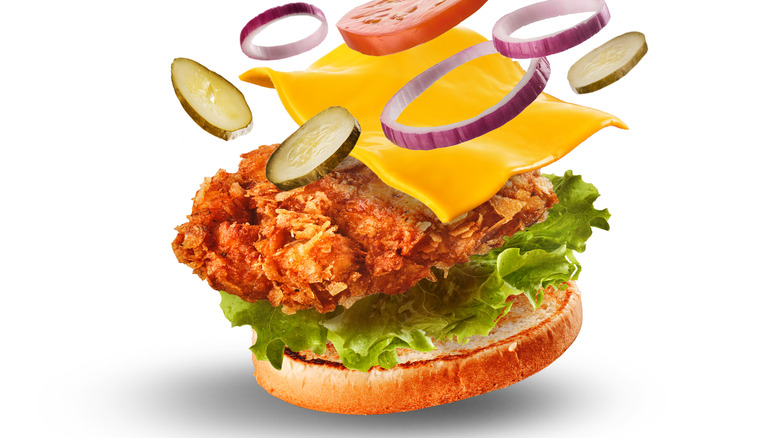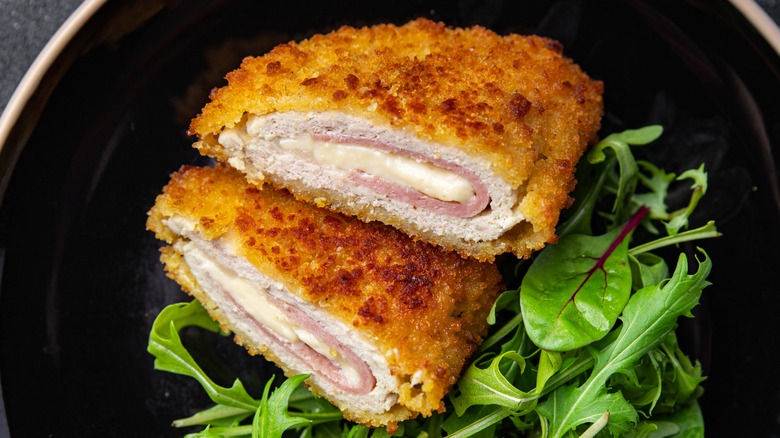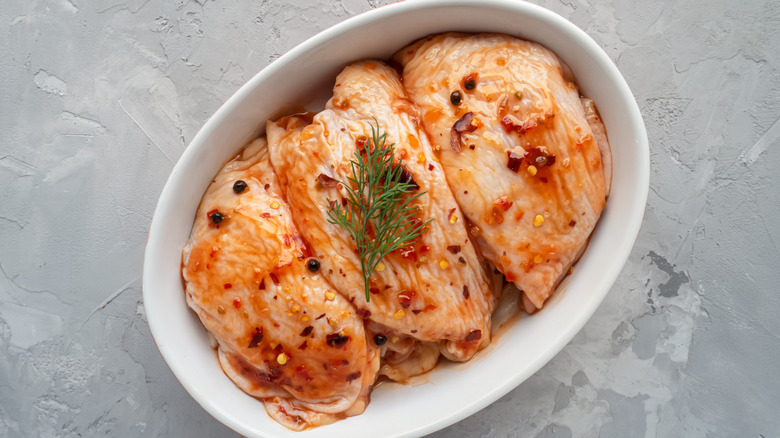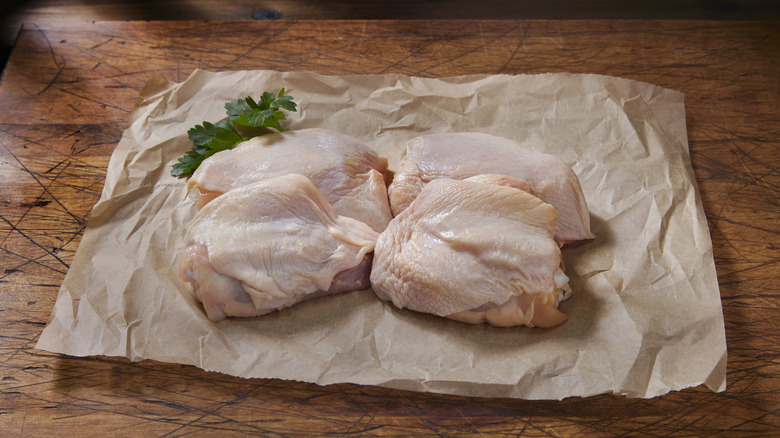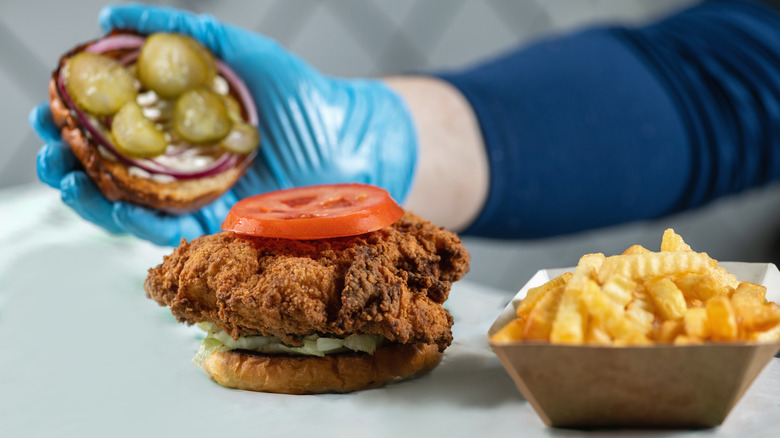14 Tips You Need When Cooking Chicken Sandwiches At Home
If you've been looking forward to that chicken sandwich you planned to make for dinner, you might want to take another look at your recipe. Chicken sandwiches can be as plain or fancy as you want, but all can suffer from fogginess, structural issues, and disappointing taste. Fortunately, certain tips can help keep the sandwich from becoming a mess, making it more likely that this chicken sandwich is one of the best you've ever had.
Something that causes people to do a sort of double-take is the fact that chicken between bread will almost always be called a chicken sandwich, even if the bread is a hamburger bun. If you want to get technical, it isn't a chicken burger unless the meat is ground and formed into a flat patty. But no matter what you call it, it's a great choice for any meal, so long as you follow these key tips for chicken sandwich success.
1. Toast the bread or bun
A fantastic yet simple change you can make to your chicken sandwich is to toast the bread or bun (this works great for fish sandwiches, too). Toasting essentially makes the bread's surface stronger, so it's easier to keep the sandwich together. This also means that toasted bread stands up better to wet ingredients. You've no doubt had a sandwich where the bread got soggy and started disintegrating in your hands, right? Toasting the bread reduces the risk of that happening. It can still become soggy, but it takes a lot longer. Hopefully, by then, you've eaten most of your chicken sandwich.
You don't have to toast each side of the pieces of bread. Instead, use a frying pan or griddle and lightly toast one side that will be facing the moist fillings. The other side will remain softer if left untoasted, which many diners find creates a far more pleasant eating experience.
2. Save diced chicken for wraps
When you choose your style of chicken for the sandwich, it's usually best to stick with patties, cutlets, or thick strips. Save smaller cuts such as chunks of chicken or diced chicken for wraps, where they'll be easier to contain. Technically, you could smear a bun or bread slice with a lot of mayo and use that as a sort of edible glue to hold the diced chicken together. Yet that can still be rather messy to eat, with bits of chicken falling out as you take more bites and the filling is gradually squeezed toward the edge of the sandwich.
Even using chicken strips can be iffy. Make sure the ones you use are wide enough to stay put as you bite into the sandwich. Or, put a semi-joking idea from the web to work and place the chicken strips in a hot dog bun. They'll certainly be easier to eat without the risk of the strip falling out.
3. Experiment with adding onions
Onions are a great topping for when you want to give your chicken sandwich a little kick but don't want to increase the actual spicy heat. Of course, the exact type of onion you use (be it white, red, sweet, or otherwise) influences the taste of the sandwich. Nevertheless, experimenting with the onions can bring out a terrific overall flavor. Pickling the onions is one option that will bring a briny edge to your sandwich. Just remember to let them dry off a bit so that the brine doesn't soak into the bun and make it soggy. You can fry or grill the onions for a crispy texture or smoky flavor.
Depending on the sauce you use and the other toppings that go into your chicken sandwich, you may or may not want a raw onion slice in all its pungent glory. That can be nice in some cases, but in others, it will dominate the potentially mild flavor of your chicken. If so, you'll need to soak the onion, which will mellow the taste a bit and make it play more nicely with the other ingredients and your tastebuds.
4. Don't forget the sauce
Another way to add flavor to your chicken sandwich is to play around with the sauce and spread choices. Ketchup, mustard, and mayo are all pretty standard, at least in the U.S., and barbecue sauce is common. But what about a roasted garlic aioli instead of mayo, or adding teriyaki sauce? Or try tzatziki or even a tomato-forward marinara. Nothing says chicken sandwiches have to play host to only one of a small group of common spreads.
Other choices include hot sauce, copycat fast food sauces, and even guacamole if you're looking for something creamy with a spicy flair. Sometimes a choice may not fully work, but at least you tried and now know not to use it. You may find that some sauces go better with fried chicken instead of baked varieties, given the textural differences between the two, or that the toppings you want clash with the taste of certain sauces. You may even find that some ingredient combinations are better without sauce or spread. All of that fine-tunes your ingredient lists for different chicken sandwiches.
5. Add crunch with cooking techniques and different ingredients
Part of the appeal of a chicken sandwich is all the different textures that combine in one bite. You could have a tasty bun, well-seasoned grilled chicken, melted cheese, and juicy tomatoes and pickles, but if every one of those ingredients is soft or easy to bite through, your brain could register the whole sandwich as unpleasantly mushy. In other words, you've simply got to have crispy, crunchy components in the sandwich to change up the sensation of chewing on it all.
One option is to toast the bun or bread. Not only does that help prevent sogginess, but it adds a crispy bite. Another is to ensure the lettuce you add is fresh and fully hydrated. Breading the chicken and frying it easily adds a lot of crunch, though you may find it adds to the cooking time, as well. You might also find that crispy bacon lends a unique smoky flavor and savory edge to the sandwich. Those different textures make the sandwich seem a lot more interesting and give it some physical substance that your brain loves to concentrate on.
6. Consider flattening chicken breasts for more even cooking
A chicken breast that you see in an advertisement or food blog tends to look very plump throughout the length of the cut and has no extra bits of meat or fat hanging off. That's fantastic for marketing but may not be the ideal — or even attainable — form if you want the chicken breast to properly cook and work in your sandwich. You're far more likely to get more consistent cooking throughout the breast if you flatten it or make it thinner. The thinner the meat, the faster it will cook, and the less chance there will be of the chicken overcooking on the outside or being underdone on the inside.
Slicing a chicken breast horizontally is great when you just want to reduce its thickness. However, if you want the entire piece to be the same thickness all over, flatten the chicken by pounding it with the bottom of a pan or a meat mallet. Always cover the chicken with something like plastic wrap first. Otherwise, each hit could send bits of chicken meat and juice flying, along with any potentially dangerous bacteria that could linger in raw chicken. If you have a particularly thick chicken breast, slice through it horizontally and then pound it flat.
7. Thoroughly wash and dry produce
When you put wet food on bread, it's easy to understand how bread absorbs the moisture and becomes soggy. This is a particular problem when you want to make chicken sandwiches in advance, especially when the chicken is fried and breaded. What's more, soggy bread doesn't hold up well and can tear easily, allowing your toppings to go crashing down onto your plate or the floor. You can coat the bread with butter, oil, or mayo, but even those condiment can lead to soggy bread if they're added too far in advance.
Vegetable toppings tend to be wet, both because they're juicy (such as tomatoes) and because you ought to wash fruits and veggies before eating them. These need to be dried completely before putting them on a chicken sandwich. Lettuce can be especially tricky because the texture of the leaves can hold onto water easily, so take a minute to pat them dry even if you've used a salad spinner. If you're making the sandwich to eat later, also keep the wet ingredients to the side until mealtime, then quickly assemble your sandwich.
8. Place greens on both slices of bread
The soggy saga doesn't end with patting things dry, however. Items like tomato slices or pickles can be so juicy that there's no way to dry them completely; you could pat all the moisture off them only to find more seeping out. If you have toppings like those, place lettuce on both the top and bottom buns, and then sandwich the juicy toppings and meat together between the lettuce so that nothing else touches the bread.
If you're adding mayo or another sauce to the sandwich, you can place them on the bread if you're eating the sandwich immediately. However, if you're a slower eater and wondering if the spread will make the bread soggy in the time it takes you to eat the sandwich, an option is to add the spreads and sauces to the other toppings and not to the bread. In other words, spread mayo on the cheese or the other side of the lettuce, the one that isn't touching the bread. With the dry lettuce being the only thing adjacent to the bread or bun, you have a better chance of having a non-soggy sandwich.
9. Keep ingredients separate if prepping
If you really want to keep moisture away from the bread or bun, pack the vegetables and sauces separately. Add them right before you intend to eat your sandwich. Also, avoid wrapping the chicken, bread, and other dry ingredients in plastic or other nonpermeable materials, as that can trap condensation right next to your ingredients and increase sogginess.
Vegetable toppings can be stored in bags, while it may help to keep the truly juicy stuff in containers separate from everything else. Sauces and spreads can go in tiny squeeze tubes or small plastic dressing containers, for isntance. And it's not unheard of to pack every ingredient in its own container, even the chicken, if you're especially worried. If you're making several sandwiches, keep everything separate and then place the different ingredients in a sandwich bar-style lineup instead of trying to prepare several sandwiches at once.
10. Use no breading or light breading
Breading on fried chicken is delicious when it's been done well ... but it's just sad when not executed perfectly. Breading that's too thick interferes with the taste and texture of the sandwich, for one; all the breading plus actual bread gives you too much of a starchy start in those first bites. Instead, use a light layer of breading or none at all.
Ensure that any breading you use stays on the chicken. That's because breading that separates too quickly from the meat ruins the proportion of flavors and textures when you bite into the sandwich. You added breading because you wanted each bite to contain a combination of breading and chicken, after all. So, seeing chunks of breading drop onto the plate is sure to be a disappointment. To avoid this, chill the chicken after coating it but before cooking it, a step that may help keep more of the breading in place.
11. Don't forget a brine or marinade
Chicken itself doesn't have much flavor. Instead, it's the seasonings and coatings that round out the taste of the meat. While you could use a dry spice rub or rely on some breading, it's better to give the chicken itself some flavor through brining or marinating. The flavor of a simple chicken brine or marinade can penetrate the meat, so even if most of the marinade or brine disappears while the chicken is cooking, the flavor can remain.
Both brining and marinating are simple. Mix ingredients, place the result in a bag or bowl, submerge the chicken in the mixture, and then, after an appropriate amount of time, take out the chicken and cook it.
Marinades generally rely on acids like a type of vinegar or lemon juice to flavor the chicken. Meanwhile, brines rely on salt and a little sugar, sometimes along with aromatics. Brines can be wet (like a mix of salt, sugar, and water) or dry (such as a salt mixture rubbed all over the meat). By the way, if you're wondering about Chick-fil-A's supposed pickle juice-brined chicken, that isn't quite genuine. The mixture is really a combination of salt, sugar, and MSG. The pickle taste reportedly comes from the pickles that are actually on the sandwich.
12. Bake chicken with olive oil or mayonnaise
One of the reasons a lot of people don't like making chicken at home is that it all too often ends up dry and rather tasteless, especially with baked chicken breasts that don't have a lot of moisture, to begin with. Many recipes for juicy chicken breasts recommend covering them when they're in the oven, but there's another trick: coat the chicken directly to keep it moist.
One option is olive oil. Add a light layer to the chicken breast or let the piece sit in a bag full of oil as a marinade. The oil also helps seasonings stay on the piece as it bakes and helps the chicken's exterior become a little more crispy. The second option is to coat the chicken with mayonnaise. Not only will the chicken absorb some of the moisture in the mayonnaise — traditionally made with just oil, egg yolks, and an acid — but the lemon or vinegar in the mayo can help make the cooked meat a little more tender.
13. Use chicken thighs for grilling
Grilling can dry out chicken quickly — after all, you're placing the chicken right over flames, which aren't known for leaving a lot of moisture around. There are two ways to avoid this dryness. One is to ensure you marinate or brine the chicken sufficiently before grilling. As with baking or pan frying, a brine or marinade can help the chicken retain moisture.
Another way that makes grilling chicken so much easier is to use chicken thighs and not breasts. Thighs have more fat, even when they don't have skin, which keeps the entire cut of chicken much more moist when cooking over those flames. You'll still want to brine or marinate the chicken for flavor, but using thighs means you can relax a little when you take the chicken off the grill (after it hits a safe internal temperature, of course). With thighs, there's less risk of overcooking and drying out.
14. Pay attention to the balances of flavor and texture
All the expert frying, grilling, and baking in the world won't mean a thing if the balance of the sandwich is off. When combining bread, chicken, vegetables, spreads, and spices into one package, you must ensure that they all work in harmony. Even though the chicken is the star, you don't want to only taste chicken, either. You may as well not bother making a sandwich.
For sandwiches that have the potential to get soggy or that are being made ahead of time, thicker bread is best, as it can withstand moisture better than thin slices. Remember that even if you've dried all your sandwich toppings, the bread can still soften up a lot as you store the sandwich. A bagel or part of a crusty loaf is a great choice here. Also, consider the amounts and types of vegetables that are easy to bite through to find your preferred bread-to-vegetable ratio.
Toppings are likewise critical. Balance crunchy, soft, acidic, and spicy elements. Have fun experimenting here with different types or amounts of pickles and a variety of cheeses. You can even consider toppings, like the differences between fresh tomato slices and sun-dried tomatoes.
